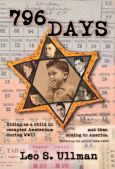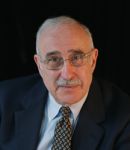| |
796 Days |
| Hiding as a child in occupied Amsterdam during WWII and then coming to America |
by Leo S. Ullman ©2015, Paperback, ISBN: 978-1-941501-12-2, 402 pp |
| |
|
 |
A mesmerizing first-person story of a young Jewish boy pushed into hiding over a period of nearly 2½ years during WWII with total strangers who did not know who he was, while his parents hid in an attic elsewhere, not knowing where their son was or whether he was alive. This all in the heart of Amsterdam during the brutal occupation by the Nazis.
Their family, long established, leading honest, law-abiding, normal and comfortable lives were suddenly forced to (in their own words) “disappear,” to “become illegal,” and to “live like rats” to avoid capture and deportation to killing camps. Yet they survived, facing constant fear of death, house-to-house searches, betrayal, disease and hunger, until liberated by the Allies.
They then left their home, their country and their friends to start anew, in the U.S., seeking freedom from oppression. They quickly grew roots, becoming active and involved in their chosen community, and were able to succeed with zeal and good fortune.
This chronicle includes not only Leo Ullman’s own personal story, but stories of other family members and their often miraculous survival. The book contains numerous unique photos, copies of documents and correspondence in support of the stories, as well as valuable historical and factual context of those terrible times.
Acknowledgments i
Foreword 1
PART I: Holland and the War Years
1 Beginnings – Amsterdam 7
2 My Parents and Their Families 10
3 Holland is Attacked 50
4 A Near-Escape 53
5 German Occupation 56
6 The Decision to Go into Hiding 75
7 A Place for Me 92
8 At the Schimmels 97
9 Frank, Emily and Bram in Hiding 102
10 Writings During the Years in Hiding 117
11 Amsterdam During the “Hunger Winter” 148
12 The End of the War 157
13 Fritz Ullmann and Family 165
14 The Plight and Separation of the Warendorfs 172
15 Life Immediately after the War 183
16 Jeannette Kalker, Bram Konijn and Family 210
17 Oma and Opa Schimmel and Family after the War 216
18 Anne Frank – Connections and Comparisons 223
19 Resistance by the Dutch and Dutch Jews 232
20 Leaving Holland and Coming to America 243
PART II: Our First Years in America: 1947-1957
21 My First Days in Port Washington 251
22 Our First Few Years in Port Washington 262
23 Mom’s Early Days in America 269
24 Pop In America 282
25 Religion 300
26 Finding My Way 310
Epilogue 337
Appendix
Additional Correspondence 347
A Friend and the Definition of a Jew 365
Paul & Berthe Hendrix Professorship 368
Dot Map 374
Genealogy 376
Timeline 380
Glossary 387
Index 393
Chapter 1
Beginnings — Amsterdam
The story begins in Amsterdam, the Netherlands. The country, the land mass of which is roughly 1½ times the size of Massachusetts, is often referred to (herein as well) as Holland, but, in fact, the term Holland referred historically to the largest and most populous province of the Netherlands. In 1840 the Province of Holland was divided into two provinces; i.e., Noord (North) Holland (which includes the city of Amsterdam) and Zuid (South) Holland (which includes both The Hague and Rotterdam). There are now 12 provinces of what is now the Netherlands; the last, Flevoland, was established in 1986 and consists largely of reclaimed land from what was once the Zuiderzee.
Both the country and Amsterdam, its cultural and financial center, date back to 1275. The seat of Government is in The Hague, but the Queen’s official palace is in Amsterdam. Referred to as the “Venice of the North,” Amsterdam’s remarkable inner city template of canals, fed by the Amstel River, was built in the 17th century, at which time Amsterdam was known as the “wealthiest city in the world.” The city’s oldest building is the “Old Church” built in the early thirteen hundreds, and rebuilt a few times since. The city even features a wooden building or two from the 1400s.The population of Amsterdam within the city limits, both in 1940 and today, is in the order of 800,000. Rotterdam, the principal port city, is somewhat larger in terms of the greater metropolitan area with a population of some 1.3 million, including an estimated majority of immigrants. The country, at approximately 12,900 square miles, is densely populated today with some 16.6 million residents; in 1940, the population numbered approximately 9 million.
The city and country have long been known for their religious tolerance. A law passed all the way back in 1579, for example, prohibited persecution based on faith.
Many Jews, including the human rights philosopher Spinoza, came to Holland and Amsterdam from the Iberian Peninsula in the mid-1600’s after the “80-year War” with Spain. The involvement of Jews in Dutch economic and social life during the “Golden Age” of Holland in the 17th century was extraordinary compared to other countries, and, unlike other countries, there was never a ghetto, as such, in Amsterdam or elsewhere in the Netherlands. Nor was there the type of virulent anti-Semitism in Holland as there was in Germany or Austria, for example. René Descartes, the French philosopher, reportedly asked at some point during that century, “In what other country can one enjoy such complete freedom; where else can one go to sleep without fear?”
Starting in the early Napoleonic era (1796), Jews were allowed in all professions in Holland; this does not mean, however, that they were in fact welcome in all. It’s fair to say that Jews historically have generally, with very limited exceptions, not reached senior levels of management in many of the country’s large commercial banks and financial institutions (ABN, AMRO, ING), nor the largest industrial companies (Philips, Shell). Prior to World War II, few Jews served in the Government. This changed noticeably in recent years, as Amsterdam has had at least 4 recent Jewish mayors.The Jewish population of Holland was approximately 140,000 as of January 1940. So-called “half Jews” (a Jew married to a non-Jew) numbered an additional 20,000. In all, the Jewish population was thus less than 2% of the country’s total population. Approximately 60% of the Dutch Jews lived in Amsterdam. There was statistically very little inter-marriage of Jews with non-Jews. In general, it is believed that most of the Jewish population went to a synagogue primarily on Jewish holidays and rarely otherwise, but most observed the Sabbath on Saturdays. There were basically two synagogues in Amsterdam, the very large and imposing Portuguese (Sephardic) synagogue built in 1671-1675 and the synagogue complex of the High German (Ashkenazi) Jews, consisting of two large and two small synagogues also dating back originally to 1671.1
One area of commercial life in Amsterdam that has been particularly identified with the Jewish population, especially from the beginning of the 20th century through the start of WW II, has been the diamond industry. In fact, that industry can be traced back to the 16th century, and by the middle of the next century was already dominated by the Portuguese Sephardic Community. Of the estimated 80,000 Jews in Amsterdam as of 1940 nearly 30% were employed in the diamond industry and in general lived well. However, a large part of the Jewish population was seriously impoverished, living in the densely populated Jodenbuurt (Jewish Quarter) near the two synagogues.
Leo S. Ullman was born in Amsterdam, the Netherlands in July 1939. After surviving WWII as a “hidden child,” as chronicled in this book, he came to the U.S. with his family in December 1947 to start a new life. He graduated from Phillips Academy, Andover, Massachusetts (1957), Harvard College (1961), Columbia University’s Graduate Schools of Law (J.D.) and Business (MBA) (both in1964). He served his country in the U.S. Marine Corps., and Marine Corps Reserves (1959 – 1965).
He returned to Holland after law school as editor of an international tax publication, and founding editor of a loose-leaf tax publication. He has written several monographs and articles, as well as a monthly column for a Dutch publication, on (foreign investment in) U.S. real estate.
Mr. Ullman, a member of the New York bar, practiced law for more than 30 years, with major New York law firms and with his own firm. As of 1970, while still practicing law, Mr. Ullman established a real estate management company, which led ultimately to the founding of a real estate investment trust, which he grew, while CEO, Chairman and President from $13 million to $1.6 billion, and which he took to the New York Stock Exchange in 2004, resulting in an award as Ernst & Young’s “Entrepreneur of the Year”
With respect to his roots, Mr. Ullman served as a Director of the Anne Frank Center USA for two decades and as its Chairman for seven years. He has also served many years as the Chairman of the Foundation for the Jewish Historical Museum of Amsterdam. He and his wife, Kay, have co-sponsored the exhibit “State of Deception: The Power of Nazi Propaganda” of the United States National Holocaust Memorial Museum in Washington, D.C., for which he has served as a member of its Development Committee.
|
|

|
Enlarge

|
|
 |
| Price: $24.95 |
 |
 Order Order |
|
|

Leo S. Ullman |
|
|
|